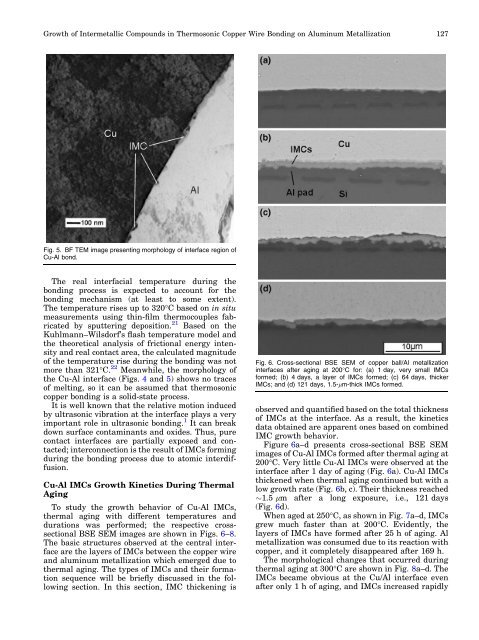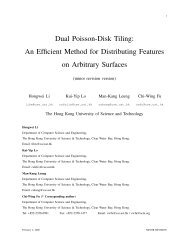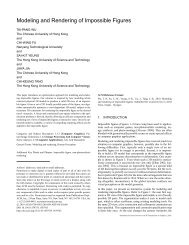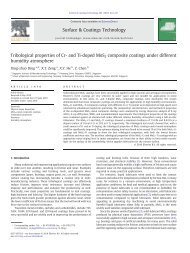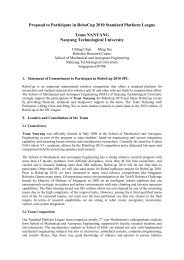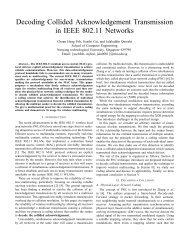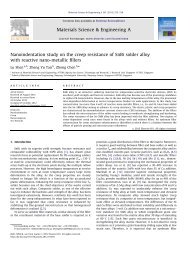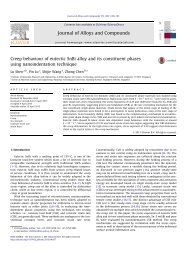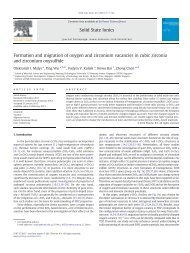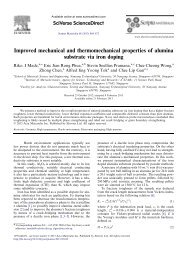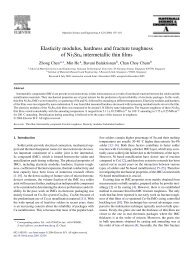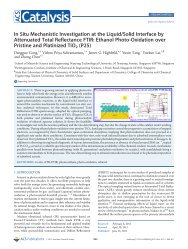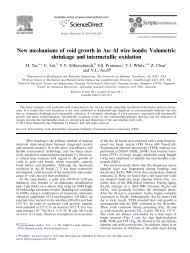Growth of Intermetallic Compounds in Thermosonic Copper Wire ...
Growth of Intermetallic Compounds in Thermosonic Copper Wire ...
Growth of Intermetallic Compounds in Thermosonic Copper Wire ...
You also want an ePaper? Increase the reach of your titles
YUMPU automatically turns print PDFs into web optimized ePapers that Google loves.
<strong>Growth</strong> <strong>of</strong> <strong>Intermetallic</strong> <strong>Compounds</strong> <strong>in</strong> <strong>Thermosonic</strong> <strong>Copper</strong> <strong>Wire</strong> Bond<strong>in</strong>g on Alum<strong>in</strong>um Metallization 127<br />
Fig. 5. BF TEM image present<strong>in</strong>g morphology <strong>of</strong> <strong>in</strong>terface region <strong>of</strong><br />
Cu-Al bond.<br />
The real <strong>in</strong>terfacial temperature dur<strong>in</strong>g the<br />
bond<strong>in</strong>g process is expected to account for the<br />
bond<strong>in</strong>g mechanism (at least to some extent).<br />
The temperature rises up to 320°C based on <strong>in</strong> situ<br />
measurements us<strong>in</strong>g th<strong>in</strong>-film thermocouples fabricated<br />
by sputter<strong>in</strong>g deposition. 21 Based on the<br />
Kuhlmann–Wilsdorf’s flash temperature model and<br />
the theoretical analysis <strong>of</strong> frictional energy <strong>in</strong>tensity<br />
and real contact area, the calculated magnitude<br />
<strong>of</strong> the temperature rise dur<strong>in</strong>g the bond<strong>in</strong>g was not<br />
more than 321°C. 22 Meanwhile, the morphology <strong>of</strong><br />
the Cu-Al <strong>in</strong>terface (Figs. 4 and 5) shows no traces<br />
<strong>of</strong> melt<strong>in</strong>g, so it can be assumed that thermosonic<br />
copper bond<strong>in</strong>g is a solid-state process.<br />
It is well known that the relative motion <strong>in</strong>duced<br />
by ultrasonic vibration at the <strong>in</strong>terface plays a very<br />
important role <strong>in</strong> ultrasonic bond<strong>in</strong>g. 1 It can break<br />
down surface contam<strong>in</strong>ants and oxides. Thus, pure<br />
contact <strong>in</strong>terfaces are partially exposed and contacted;<br />
<strong>in</strong>terconnection is the result <strong>of</strong> IMCs form<strong>in</strong>g<br />
dur<strong>in</strong>g the bond<strong>in</strong>g process due to atomic <strong>in</strong>terdiffusion.<br />
Cu-Al IMCs <strong>Growth</strong> K<strong>in</strong>etics Dur<strong>in</strong>g Thermal<br />
Ag<strong>in</strong>g<br />
To study the growth behavior <strong>of</strong> Cu-Al IMCs,<br />
thermal ag<strong>in</strong>g with different temperatures and<br />
durations was performed; the respective crosssectional<br />
BSE SEM images are shown <strong>in</strong> Figs. 6–8.<br />
The basic structures observed at the central <strong>in</strong>terface<br />
are the layers <strong>of</strong> IMCs between the copper wire<br />
and alum<strong>in</strong>um metallization which emerged due to<br />
thermal ag<strong>in</strong>g. The types <strong>of</strong> IMCs and their formation<br />
sequence will be briefly discussed <strong>in</strong> the follow<strong>in</strong>g<br />
section. In this section, IMC thicken<strong>in</strong>g is<br />
Fig. 6. Cross-sectional BSE SEM <strong>of</strong> copper ball/Al metallization<br />
<strong>in</strong>terfaces after ag<strong>in</strong>g at 200°C for: (a) 1 day, very small IMCs<br />
formed; (b) 4 days, a layer <strong>of</strong> IMCs formed; (c) 64 days, thicker<br />
IMCs; and (d) 121 days, 1.5-lm-thick IMCs formed.<br />
observed and quantified based on the total thickness<br />
<strong>of</strong> IMCs at the <strong>in</strong>terface. As a result, the k<strong>in</strong>etics<br />
data obta<strong>in</strong>ed are apparent ones based on comb<strong>in</strong>ed<br />
IMC growth behavior.<br />
Figure 6a–d presents cross-sectional BSE SEM<br />
images <strong>of</strong> Cu-Al IMCs formed after thermal ag<strong>in</strong>g at<br />
200°C. Very little Cu-Al IMCs were observed at the<br />
<strong>in</strong>terface after 1 day <strong>of</strong> ag<strong>in</strong>g (Fig. 6a). Cu-Al IMCs<br />
thickened when thermal ag<strong>in</strong>g cont<strong>in</strong>ued but with a<br />
low growth rate (Fig. 6b, c). Their thickness reached<br />
1.5 lm after a long exposure, i.e., 121 days<br />
(Fig. 6d).<br />
When aged at 250°C, as shown <strong>in</strong> Fig. 7a–d, IMCs<br />
grew much faster than at 200°C. Evidently, the<br />
layers <strong>of</strong> IMCs have formed after 25 h <strong>of</strong> ag<strong>in</strong>g. Al<br />
metallization was consumed due to its reaction with<br />
copper, and it completely disappeared after 169 h.<br />
The morphological changes that occurred dur<strong>in</strong>g<br />
thermal ag<strong>in</strong>g at 300°C are shown <strong>in</strong> Fig. 8a–d. The<br />
IMCs became obvious at the Cu/Al <strong>in</strong>terface even<br />
after only 1 h <strong>of</strong> ag<strong>in</strong>g, and IMCs <strong>in</strong>creased rapidly


